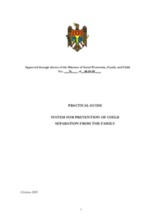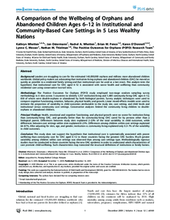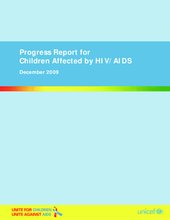Demographic Data:
|
Sources: World Bank, UNDP, DHS 2010-11 |
Displaying 13191 - 13200 of 14347
This "Practical Guide: System for Prevention of Child Separation from the Family" was developed in cooperation with the Ministry of Social Protection, Family and Child with technical support from the "Support to the Delivery of Efficient and Sustainable Social Assistance Services” project implemented by OPM/EveryChild Moldova, funded by DFID/SIDA.
This report from the International Labor Organization is the first in a series of the World Social Security Reports whose chief aim is to present the results of regular statistical monitoring of the state and developments of social security in the world. It presents the knowledge available on coverage by social security in different parts of the world and identifies existing coverage gaps. It also examines the scale of countries’ investments in social security, measured by the size and structure of social security expenditure and the sources of its financing.
Guidance and forms on preventing institutionalization of children and promoting family unification. The manual includes good practices and lessons learnt, training plans, care planning forms, and assessment guidance.
Conference programme, background papers, key policy recommendation from 2009 Wilton Park conference event
Guidance for practitioners involved in child care reform, including direction on planning for de-institutionalization in parallel with community based services
Offers updates, authoritative data, evidence and recommendations on key areas including prevention of mother-to-child transmission, paediatric care and treatment, preventing infection among adolescents and young people, protection, care and support for children affected by HIV and AIDS, programme monitoring and evaluation.
Global policy makers are advocating that institution-living orphans and abandoned children (OAC) be moved as quickly as possible to a residential family setting and that institutional care be used as a last resort.
The latest in a series of reports produced by UNICEF on the status of orphans and vulnerable children (OVC). This is an easy-to-use reference document for policymakers and key stakeholders who work in the response for orphans and vulnerable children. It presents the 17 indicators described in the Guide to Monitoring and Evaluation of the National Response for Children Orphaned and Made Vulnerable by HIV/AIDS
As a result of the HIV/AIDS pandemic, there are now more than 12 million orphans in sub-Saharan Africa. The majority of these children have been absorbed into their extended families.
This scoping study assesses the nature and extent of the evidence base in relation to increasing the number of care leavers in ‘settled, safe accommodation’. The Social Care Institute for Excellence (SCIE) carried out the study on behalf of the Centre for Excellence and Outcomes in Children and Young People’s Services (C4EO), between November 2008 and February 2009.








